 |
North
High School Wall of Honor
Harlan William Lekowsky
Class of June, 1943
|
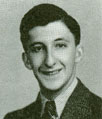 |
 |
|
Research done by Claradell Shedd, Class of 1953. PAGE IN PROGRESS |
| Harlan
William Lekowsky |
| Harlan
was a member of North High's class of June, 1943. His next of kin was
Mr. Abe Lekowsky who lived at 1304 12th Street, Des Moines, IA. Harlan's
service number was 37676121. |
| Harlan William Lekowsky |
 |
| Year |
|
Rank |
|
Status |
 |
| June, 1943 |
|
x |
|
Graduated from North High,
Des Moines, IA |
| July, 1943 |
x |
Enlisted;
US Army |
x |
Camp Dodge, IA. (I was
18 years old in May.) |
| July, 1943 |
|
US Army
|
|
Three months of basic training at
Camp Beale, CA
Combat Engineers Training Center |
| 1943 |
x |
US Army |
x |
Three months in Mohave
Desert on CA/AZ border. We slept under trucks. Eventually pitched
tents for housing. |
| date |
x |
US Army |
x |
Furlough back to Des Moines |
| date |
x |
US Army/Cpl. |
x |
One month at Camp Ellis
to train as plumber. Appointed plumber foreman at Ellis. |
| date |
x |
US Army |
x |
Took train to combat infantry
training. Training until July, 1944.
San Luis Obispo, CA |
| July, 1944 |
x |
Enroute |
x |
Dutch freighter Clip Fontaine
from San Francisco to Milne Bay, New Guinea. |
| date |
x |
On location |
x |
Milne Bay, New Guinea. Combat infantry
in jungles in the afternoon. At night loaded ammo and supplies
onto ships. Lived in tents. |
| date |
x |
On location |
x |
Moved to Orol Bay?, New
Guinea. Ready to invade Leyte in Philippines. |
| date |
x |
On location |
x |
From MacArthur's Headquarters
in New Guinea to Leyte in Philippines. |
date
|
x |
On location |
x |
Mount Haven? to Leyte, Philippines
on LST's. Bay was heavily mined, so we had to climb nets and take
"water/land ducks" for land access. |
| Oct., 1944 |
x |
On location |
x |
Tacloban, Philippines. Combat infantry
depot in Tacloban. Foxholes. Shrampnel ripped knee. First aid
canvas tent with dirt floor. Bandaged me up and said, "are
you ready to go back out?" I said, "Yes." |
| date |
x |
On location |
x |
27th Combat Engineers to Limon, Philippines.
We landed in valley and settled in an area of a ravine. Enemy
fire from above went over our heads. We were trapped, but our
group of 200 got out. |
| date |
x |
On location |
x |
Road washed out. We were assigned
to rebuild road. I was taking a few minutes of rest on a hillside,
when a U.S. vehicle approached and someone said, "Hello,
Harlan." It was Jack Frazier who had been my classmate in
an English class at North High. Jack Frazier eventually opened
Frazier Optical in Des Moines. |
| date |
x |
On location |
x |
Leyte, Philippines campaign ended.
Ready for another invasion.
Subic Bay, Philippines. (Luzon) |
| date |
x |
On location |
x |
Balete Pass |
| date |
x |
On location |
x |
Batangus, Philippines. Then Manila,
Philippines
Rizal Stadium. There several weeks. |
| June, 1945 |
x |
Enroute |
x |
Left Manila, Philippines. |
| Aug., 1945 |
x |
Enroute |
x |
Lingnan Gulf (seaport). August 14th
the war was over. |
| date |
x |
Training |
x |
They wanted me to take more training
in plumbing. |
| date |
x |
Enroute |
x |
Nagoya, Japan. Hurricane hit and
a lot of our equipment was lost at sea. We entered small city
outside of Nagoya, Japan. I carried my M-1 rifle and ammo. We
walked into village where there were about 15 shops/owners selling
bamboo wares, etc. The people closed their shops when they saw
us and eventually encircled our group. We expected resistance,
but the people welcomed us with friendly gestures. There was a
shop owner who came forward saying, "I grew up in San Francisco."
We were able to easily communicate through this woman. |
| date |
x |
On location |
x |
Osaka, Japan. Lived in Japanese barracks.
Japanese bathing was done communally in 40x60 ft. pool (approximately
3 feet deep). The GI's decided they would create their own bathing
facilities. As a plumber, I was able to "pipe" our system,
another GI was a heating expert who created a heating unit to
warm the water, and, since we could not find shower heads anywhere,
a sheet metal expert took tin cans and perforated them with holes...we
had hot and cold running water for our newly-created showers!
The ingenuity of necessity! After 18 months of K-rations, we finally
were able to obtain fresh food. |
| Dec., 1945 |
x |
On location |
x |
Osaka, Japan to San Francisco,
CA via *USS Admiral H.T. Mayo. Arrived in San Francisco, CA on
January 2, 1946. |
late Jan.
1946 |
x |
Enroute |
x |
Rented a car and drove
to Des Moines. Then had to return back to San Francisco, CA. We
then took a train to Fort Logan, CO for official discharge. |
| 1946 |
x |
Employed |
x |
Joined my parents in
a plumbing/used furniture store at East 5th and Grand. Worked
there for 22 years. |
| 1987 |
x |
Interest |
x |
Approached by Judicial
Court System in IA to be mediator in the Small Claims Court System.
To Cedar Rapids, IA to train as mediator.
Awarded Amicus Curiae ("Friend of the Court") by the Polk County
Small Claims Mediation Program. Judicial Branch Awards for 2005.
(January-June, 2006)
See
write-up. Scroll to page 5. OR if you input www.judicial.state.ia.us.
In the left column, click on Administration. Then click on Newsletters.
Then select January-June 2006 Newsletter. Then select page 5. |
|
*USS
Admiral H. T. Mayo, a 9,676-ton (light displacement) Admiral W. S. Benson
class transport built at Alameda, California to the Maritime Commission's
P2-SE2-R1 design, was commissioned in April 1945. After shakedown she
steamed to the Atlantic and, in June, carried 5,819 released prisoners
of war from Le Havre, France, to Boston. Her next voyage took her to
Marseilles, France, where she embarked 4,888 quartermaster and engineer
troops and transported them to Okinawa, arriving in September. Admiral
H. T. Mayo then began the first of several "Magic Carpet"
trips, bringing servicemen home from the Western Pacific. The ship completed
the last of these voyages in April 1946 and sailed for New York, where
she was decommissioned in May 1946 and transferred, via the Maritime
Commission, to the U.S. Army.
Specifics of the USS Admiral H.T. Mayo:
What Goes On Inside the Mayo
If you were to take the entire population of a town the size of Las
Vegas, New Mexico, and put it on board a ship 608 feet long, that displaced
24,000 tons, and traveled through the briny deep at 25 miles an hour,
you would have to admit that you had accomplished something out of the
ordinary.
Inside this huge structure, however, is a veritable beehive of activity,
one that has the makeup, equipment, and modern conveniences of that
most ultra-modern city.
A ship's service store which wells everything from cigars to ladies'
silk stockings, does a tremendous business; as does the clothing store
which can completely outfit any member of our crew.
A group of experts who can do a neat job of arc-welding, or wield a
hammer and saw from which will emanate library shelves or a portable
stage for entertaining troops. A fire-fighting unit that is made up
of expert ex-firemen from back home.
Our engine rooms ( there are two of them) are formidable things to see,
manned by engineers, electricians, firemen, and water tenders. With
a machinery plant that cost approximately $5,000,000, the engineering
department is responsible for 20,000 horsepower, 80,000 gallons of fresh
water every 24 hours, as well as 18,000 kilowatts of electricity.
Our gigantic fuel tanks have a capacity of over one million gallons
of fuel oil, which is enough to take the Mayo around the world, plus
106 vent systems, 30 miles of piping, over 300,000 rivets, 190 miles
of welding, and a huge fresh water storage tank that will allow 800,000
gallons of emergency supply, complete a top-notch engineering project.
When it comes to show, well the figures we are going to give you are
astounding. For example, it took 5,000 lbs. of ham to feed the troops
in one single day. It took 2,000 lbs. of pork sausage for one breakfast
alone. And speaking of one breakfast it might interest you to know that
it requires 14,780 fresh eggs... it took all night to crack them.
A few other items we might mention are that yesterday's
menu called for 7,000 lbs of potatoes, 2,500 lbs of sugar, 1,800 loaves
of bread, 1,000 lbs. of coffee, 2,000 lbs. of pears, 800 lbs. of rice,
540 lbs. of butter, 350 gallons of ice cream, 1,000 lbs. of milk powder,
-- and 12 lbs. of that precious little black stuff that you can't
get in the States, -- pepper.
All of our foodstuffs come from a gigantic warehouse that has over
a quarter of a million lbs. of meat, 170,000 lbs. of flour, 100,000
lbs. of sugar, potatoes, and fresh vegetables each, and approximately
400 tons of canned goods.
If you should be taken ill, even seriously, although we hope this
never happens, our hospital, complete in every detail, with treatment
clinic, x-ray lab, pharmacy, biological lab, and operating room, can
handle any medical situation.
Beyond the horizon, by day and night, in fog or rain,
our seeing-eye radar is able to indicate the approach of another ship
to the navigator. Our ship is steered by a man who turns a small wheel;
electricity transmits his instructions to a great hydraulic ram which
swings the rudder, weighing many tons, from side to side.
We have, as you know, the best band in the service, made up of some
of the leading musicians from the most famous dance bands in the country.
The best radio programs obtainable are sent out over our loud-speakers
for the entertainment of all hands. On a good sunny day, you won't
find a better sun-bathing beach anywhere than on the decks of the
USS Admiral H. T. Mayo.
|
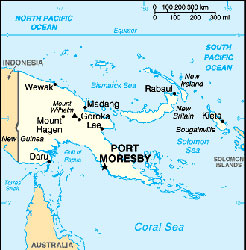
|
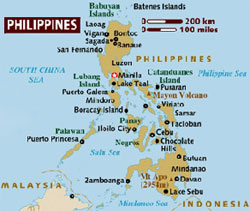 |
Left: New
Guinea
Right: Philippines Islands |
|
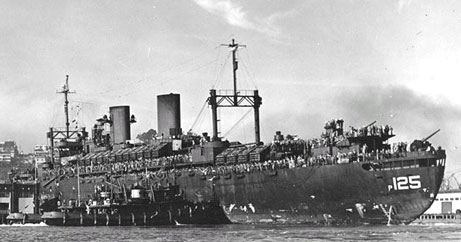 |
| Coming Home! (Mayo/AP-125). |
|

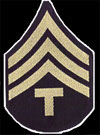
|
Harlan
William Lekowsky
Tech 4
27th Army Combat Engineers

Harlan Lekowsky photo
|
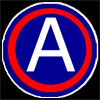

|
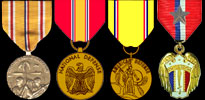
Medals
Medals to include WWII victory medals for campaigns
in Southern Philippines, Luzon, and New Guinea.
American Service Medal, Asiatic-Pacific Service Medal, Philippine
Liberation plus Bronze Star |
|
| References |
(1)
The World War II Army Enlistment Records contain information on
more than nine million indivdual enlistments. These records can
be found online at http://www.archives.gov/.
(2) The comprehensive list of names from North High's 1893-2018
graduation classes are from Claradell Shedd's North Des Moines
High School website. The names of North High School graduates
can be found online at: http://www.ndmhs.com/.
Harlan William Lekowsky's 1943 class page is: http://www.ndmhs.com/pages/yearclass1943(2008.65).html. |
|
|
06/10/10. Living in West Des Moines, IA. |
| Music:
"Wind Beneath My Wings" |
Home
|
Back/allyears |
WWI |
WWII |
Korea |
Vietnam |
Afghanistan/Iraq |
Lyrics
|
Refs/Awards |
Contact
©2025-csheddgraphics All rights reserved.
All images and content are © copyright of their respective copyright
owners. |
|









